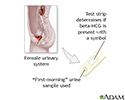Pregnancy test
A pregnancy test measures a hormone in the body called human chorionic gonadotropin (HCG or hCG). HCG is a hormone produced during pregnancy. It appears in the blood and urine of pregnant women as early as 10 days after conception.
Human chorionic gonadotropin
This type of human chorionic gonadotropin (HCG or hCG) test checks if there is a hormone called human chorionic gonadotropin in your urine. HCG is a...

How the Test is Performed
A pregnancy test is done using blood or urine. There are 2 types of blood tests:
- Qualitative, which measures whether the HCG hormone is present
- Quantitative, which measures how much HCG is present
The blood test is done by drawing a single tube of blood and sending it to a laboratory. You may wait anywhere from a few hours to more than a day to get the results.
The urine HCG test is most often performed by placing a drop of urine on a prepared chemical strip. It takes 1 to 2 minutes for a result.
How the Test will Feel
For the urine test, you urinate into a cup.
For the blood test, the provider uses a needle and syringe to draw blood from your vein into a tube. Any discomfort you might feel from the blood draw will only last a few seconds.
Why the Test is Performed
This test is done to:
- Determine if you are pregnant
- Diagnose abnormal conditions that can raise HCG levels
- Watch the development of the pregnancy during the first 2 months (quantitative test only)
Normal Results
The HCG level rises rapidly during the first trimester of pregnancy and then slightly declines.
What Abnormal Results Mean
The HCG level should almost double every 48 hours in the beginning of a pregnancy. An HCG level that does not rise appropriately may indicate a problem with your pregnancy. Problems related to an abnormal rising HCG level include miscarriage and ectopic (tubal) pregnancy.
Ectopic (tubal) pregnancy
An ectopic pregnancy is a pregnancy that occurs outside the womb (uterus).

An extremely high level of HCG may suggest a molar pregnancy or more than one fetus, for example, twins.
Your provider will discuss the meaning of your HCG level with you.
Considerations
Urine pregnancy tests will only be positive when you have enough HCG in your blood. Most over-the-counter home pregnancy tests will not show that you are pregnant until your expected menstrual cycle is late. Testing before this will often give an inaccurate result. The HCG level is higher if your urine is more concentrated. A good time to test is when you first get up in the morning.
If you think you are pregnant, repeat the pregnancy test at home or at your provider's office.
References
Jeelani R, Bluth MH. Reproductive function and pregnancy. In: McPherson RA, Pincus MR, eds. Henry's Clinical Diagnosis and Management by Laboratory Methods. 24th ed. Philadelphia, PA: Elsevier; 2022:chap 26.
Nerenz RD, Braga JA. Pregnancy and its disorders. In: Rifai N, Chiu RWK, Young I, Burnham C-AD, Wittwer CT, eds. Tietz Textbook of Laboratory Medicine. 7th ed. St Louis, MO: Elsevier; 2023:chap 59.
-
Pregnancy test - illustration
The qualitative urine human chorionic gonadotropin (HCG) test is a pregnancy test that can be performed at home by a woman to determine pregnancy. To perform the test the woman places the test strip, which has a chemically sensitive substance, under her urine stream. Within minutes the test reveals whether the woman is positive (pregnant), or negative (not pregnant).
Pregnancy test
illustration
-
Pregnancy test - illustration
The qualitative urine human chorionic gonadotropin (HCG) test is a pregnancy test that can be performed at home by a woman to determine pregnancy. To perform the test the woman places the test strip, which has a chemically sensitive substance, under her urine stream. Within minutes the test reveals whether the woman is positive (pregnant), or negative (not pregnant).
Pregnancy test
illustration
Review Date: 10/15/2024
Reviewed By: John D. Jacobson, MD, Professor Emeritus, Department of Obstetrics and Gynecology, Loma Linda University School of Medicine, Loma Linda, CA. Also reviewed by David C. Dugdale, MD, Medical Director, Brenda Conaway, Editorial Director, and the A.D.A.M. Editorial team.


